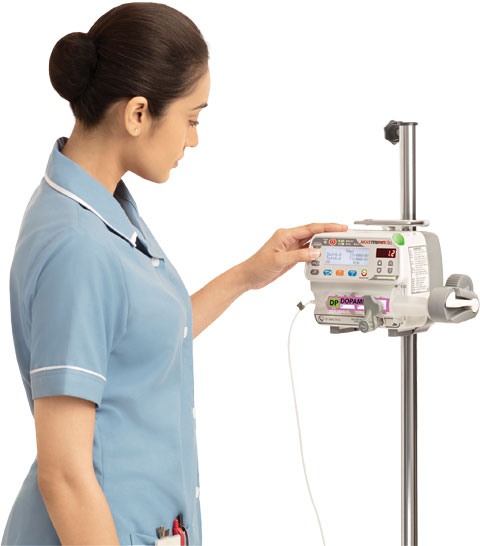
Drugs are diluted and on continuous infusion through syringe pumps or volumetric infusion pumps. The syringe or the IV container where these drugs are loaded have to be labelled and the drug name and concentration of the drug has to be mentioned for proper identification. Some drugs run for many days while some are not used beyond a few hours/days. Hence, the date and time of loading the drug should also be mentioned on the label.
If there is a mistake in the dilution of the drug, it cannot be identified unless the mixed sample is tested in the laboratory, leading to a costly affair. To inculcate a sense of responsibility in the staff and ensure proper handling, some hospitals follow a specific protocol. They make it a norm to disclose the staff initiating the dilution of drugs, making the attendants accountable for their actions.
Some hospitals have a protocol of mentioning the ml/Hr equivalent of the dose in the label to make it easy for the nurses to convert the order issued by the doctor in dosage to equivalent mL/Hr.
Mentioning adequate information on the syringe is important, so it gets tough when there is little space on the label. However, the label should also not be too large. It might end up covering the complete syringe and block the visual inspection of the infused volume on the graduation of the syringe.
For instance, doctors in a neonatal ICU use a 5 or 10 ml syringe. However, it becomes difficult to add all the information as the syringe is small for the label size.

In developing countries, there are no standardized labels and they use plasters and ball pens to write drug names and concentration. The legibility is very poor as it depends on the handwriting of the nurse. The ink on the plaster also gets removed when the drugs fall or saline drips from the higher mounted pumps. For such reasons, manually writing on plasters leads to a lot of problems and inconvenience.
In the case of developed nations, the medical fraternity has moved on to printed labels. Besides, there is a standardized colour coding for drug labels. Using this standard, the drugs are classified into14 or 15 categories.
AKAS is not just a manufacturer of Infusion pumps, but also a solution provider that ensures proper drug delivery in ICU. We make sure to reduce the nursing load, thereby improving nursing efficiency and reducing medication errors.
This classification of drugs into standard colours has been mainly carried out by a few associations of Anaesthesiologists. Some such standards are:
AKAS adds credibility since it supplies the drug labels as per the International standards.
The drug labels are sized in such a way that they can be stuck comfortably on 50mL, 20mL, and 10 mL syringes. We ensure that the drug labels are not too large as it may block the view of the graduation marks on the syringe. So the width is limited to a size of 13 mm.
The information available on our drug labels are as follows:

The label is covered with the background colour for over 70% of the area. The background colour is based on the drug class. For example, Vasopressors are violet background colour. There are more than 5 vasopressors, which will have the same background colour. To differentiate the drug name within the class of drugs, AKAS has created a square window area, which has another colour that is unique for the particular drug. For example, Dopamine is a vasopressor which has 70% violet, but also has a Green square area which signifies Dopamine with bold letters DP on it. Noradrenaline is also a vasopressor with Violet background, but the square area is in Orange with bold letters NOR. Thus, each drug has two colors, one signifying the class of the drug and covers 70% of the area, and the other is unique to the drug, which includes a square area. It makes it easy for the nursing staff to quickly get accustomed to the combination of the two colours for each drug. When they start using the drug label, they will get used to it and will be able to identify DOPAMINE as Violet with Green and NORADRENALINE as Violet with Orange. In developing countries like India, more than 90% of the hospitals use plasters and have no standard labels. Many corporate hospitals have labels for some toxic drugs. Some hospitals print their labels without following the colour coding standards, which is also dangerous. The nursing staff keeps changing hospitals and is not able to register in their mind the standard coding, thereby giving a room for errors. If the mind sees different colorsfor the same drugs, they will not attach importance to the colours, and the purpose of colours will get lost. If the meaning of the colours is lost, then it is difficult to train the mind back to a standard colour-coding. At AKAS, we value safety and believe in making it a norm. Hence, using a standard colour code will enhance the safety of medication delivery not just in a particular hospital, but across the nation as the nursing staff may shift within a country to a large extent. AKAS have also started educating the nurses at the nursing school about the labels, their importance and colour coding. This is helping in inculcating a good practice at the education level. The same drug labels can be pasted at the end of the drug delivery line to trace the delivery line when multiple infusion lines are running to a single patient.
Drug Labels of International standard for the drug class combined with unique colouring for the individual drugs will help to reduce medication errors and the cognitive load of the nurses.